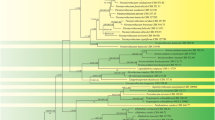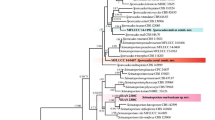Abstract
Barringtonia racemosa (Lecythidaceae) is a widely distributed mangrove associate in coastal areas of Africa, Asia and Australia. During routine disease surveys along the east coast of the KwaZulu-Natal Province in South Africa, B. racemosa trees were observed with symptoms of leaf and fruit spot. A novel species of Pseudocercospora was commonly associated with these symptoms. This fungus is described as Pseudocercospora mapelanensis sp. nov., based on multi-gene sequence analyses for the ACT, ITS, LSU and TEF gene regions, as well as morphological characteristics.




Similar content being viewed by others
References
Braun U, Mouchacca J (2000) Cercosporoid hyphomycetes on Barringtonia species. Sydowia 52:73–77
Braun U, Mouchacca J, McKenzie EHC (1999) Cercosporoid hyphomycetes from New Caledonia and some other South Pacific islands. N Z J Bot 37:297–327
Carbone I, Kohn LM (1999) A method for designing primer sets for speciation studies in filamentous ascomycetes. Mycologia 91:553–556
Chantaranothai P (1995) Barringtonia (Lecythidaceae) in Thailand. Kew Bull 50:677–694
Crous PW (2009) Taxonomy and phylogeny of the genus Mycosphaerella and its anamorphs. Fungal Divers 38:1–24
Crous PW, Braun U (2003) Mycosphaerella and its anamorphs, vol 1, CBS biodiversity series. Centraalbureau voor Schimmelcultures, Utrecht, pp 1–571
Crous PW, Groenewald JZ, Pongpanich K, Himaman W, Arzanlou M, Wingfield MJ (2004) Cryptic speciation and host specificity among Mycosphaerella spp. occurring on Australian Acacia species grown as exotics in the tropics. Stud Mycol 50:457–469
Crous PW, Summerell BA, Mostert L, Groenewald JZ (2008) Host specificity and speciation of Mycosphaerella and Teratosphaeria species associated with leaf spots of Proteaceae. Persoonia 20:59–86
Ellison AM, Farnsworth EJ (2001) Mangrove communities. In: Bertness MD, Gaines SD, Hay ME (eds) Marine community ecology, vol 16. Sinauer Associates, Sunderland, pp 423–442
Guindon S, Gascuel O (2003) A simple, fast and accurate method to estimate large phylogenies by maximum-likelihood. Syst Biol 52:696–704
Jacobs K, Bergdahl DR, Wingfield MJ, Halik S, Seifert KA, Bright DE, Wingfield BD (2004) Leptographium wingfieldii introduced into North America and found associated with exotic Tomicus piniperda and native bark beetles. Mycol Res 108:411–418
Katoh K, Standley DM (2013) MAFFT Multiple sequence alignment software version 7: improvements in performance and usability. Mol Biol Evol 30:772–780
Moncalvo JM, Rehner SA, Vilgalys R (1993) Systematics of Lyophyllum section Difformia based on evidence from culture studies and ribosomal DNA sequences. Mycologia 85:788–794
Osorio JA, Wingfield MJ, Roux J (2014) A review of factors associated with decline and death of mangroves, with particular reference to fungal pathogens. S Afr J Bot. doi:10.1016/j.sajb.2014.08.010
Posada D (2008) jModelTest: phylogenetic model averaging. Mol Biol Evol 25:1253–1256
Raeder U, Broda P (1985) Rapid preparation of DNA from filamentous fungi. Lett Appl Microbiol 1:17–20
Rayner RW (1970) A mycological colour chart. CMI and British Mycological Society, Kew
Ronquist F, Teslenko M, van der Mark P et al (2012) MrBayes 3.2: efficient Bayesian phylogenetic inference and model choice across a large model space. Syst Biol 61:539–542
Shivas RG, Young AJ, Crous PW (2009) Pseudocercospora avicenniae. Persoonia 23:192–193
Spalding M, Kainume M, Collins L (2010) World atlas of mangroves. The nature conservancy. Int Soc Mangrove Ecosyst 1–304
Swofford DL (2003) PAUP*. Phylogenetic Analysis Using Parsimony (*and Other Methods). Version 4. Sinauer Associates, Sunderland, Massachusetts
Tamura K, Stecher G, Peterson D et al (2013) MEGA6: molecular evolutionary genetics analysis version 6.0. Mol Biol Evol 30:2725–2729
Tomlinson PB (1986) The botany of mangroves. Cambridge University Press, Cambridge, p 413
USDA, ARS, National Genetic Resources Program (2014). Germoplasm resources information network - (GRIN) online database. National Germoplasm resources laboratory, Beltsville, Maryland. URL: http://www.ars-grin.gov/cgi-in/npgs/html/taxon.pl?6514 (10 December 2014)
Vilgalys R, Hester M (1990) Rapid genetic identification and mapping of enzymatically amplified ribosomal DNA from several Cryptococcus species. J Bacteriol 172:4238–4246
White TJ, Bruns T, Lee S, Taylor J (1990) Amplification and direct sequencing of fungal ribosomal RNA genes for phylogenetics. In: Innis MA, Gelfand DH, Sninsky JJ, White TJ (eds) PCR protocols: a guide to methods and applications. Academic, San Diego, pp 315–322
Acknowledgments
This work was financially supported by the Department of Science and Technology (DST) and National Research Foundation (NRF) Center of Excellence in Tree Health Biotechnology (CTHB). We thank Ezemvelo KZN Wildlife and the Isimangaliso Wetland Park for sampling permits and assistance in the field. The material was collected under EKZNW permit no OP 4776. We are also grateful to Prof. dr U. Braun (Martin-Luther-University, Institute of Biology, Halle, Germany), for his assistance in examining the fungal material and for his valuable suggestions regarding the diagnosis of the new Pseudocercospora species. We also acknowledge Ariska Van der Nest, Arista Fourie and James Mehl (FABI, University of Pretoria), for technical assistance.
Author information
Authors and Affiliations
Corresponding author
Rights and permissions
About this article
Cite this article
Osorio, J.A., Wingfield, M.J., de Beer, Z.W. et al. Pseudocercospora mapelanensis sp. nov., associated with a fruit and leaf disease of Barringtonia racemosa in South Africa. Australasian Plant Pathol. 44, 349–359 (2015). https://doi.org/10.1007/s13313-015-0357-4
Received:
Accepted:
Published:
Issue Date:
DOI: https://doi.org/10.1007/s13313-015-0357-4




